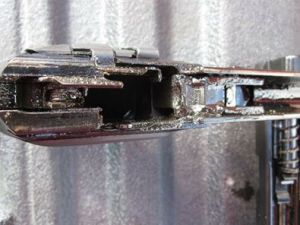Yes, Experience Matters.
Yes, experience matters.
When I started in the armory at DSS in March of 2008, the FTU was burning through guns at a ridiculous rate. I wasn’t an experienced armorer. I was a reformed Marine 0311 who was a recent graduate of gunsmithing school. I showed up with a degree of end user experience and exposure to weapons repair and firearms design theory, with a splash of metallurgy and BBQ101. Experience isn’t merely exposure. It is exposure met with endurance in an intellectual contest of wills between the designers intent, and the Laws of Thermodynamics. For myself, and any armorer at Diplomatic Security’s Defensive Equipment shop (The DE of DEAV) this is learning from a fire hose. During my time there, I was either one of two to one of four armorers, tasked with maintaining 40,ooo weapons worldwide. Being co-located with the Firearms Training Unit, we saw how guns break. But I digress…
Back to the Cart O’Guns. This wasn’t a bad day in the office. This was everyday. We had three carts that were in continual use being filled and emptied. There are still highly capable armorers there doing it to this day. (Hey PHIL!)
What you see is roughly two dozen tagged M4A1’s and Mk18s that are FTU High Threat training guns. These guns are shot hard. When I first started, these training guns were a monthly occurrence. It was unbelievable. It might not have been 24 guns, maybe 12 out of a 28 student class. Broken bolts were extremely common (as pictured below) Take notice, I didn’t clean these bolts for this picture. Spotless broken bolts were turned in for LTI. You can see the shininess of the bolt where natural lapping occurs. What is unnaturally shiny are the flanks of the bolt which have been polished through excessive cleaning. The bolt broke due to stress cycles, not fouling. And knowing the “additives” used, (militec) the care taken actually truncated the service life.
With the cooperation between my shop and FTU, hat tip to Matt Jacques, we worked hard to change minds on how the weapons were treated. We did comparative testing between the house special blend of (CLP, MILITEC, and REM OIL) we began a long term test of Slip 2000. In the armory we were using Slip 725 degreaser and Carbon Killer. Eventually, the shops went completely to Slip 2000 as it was superior in every way, and it is much safer for the people and the property to use only products formulated to work together. In that period, I had convinced the FTU as the armorer, to reduce their maintenance cycles. Before long, the attrition rate of down guns dwindled. It wasn’t a bi weekly crush of weird broken parts. It was a predictable cascade, where all the guns were gauging the same, and needing rebuilds at a comparative rate. These training guns, that’s an M4A1, Mk18, G19, Sig P229R, per student, and several M249, M240s, and even M2QCB’s and Mk19’s were all cleaned once… ONCE. The students through out the week were urged to lube their weapons, and we periodically checked bores for squibs due to frange use and overall ammo Q/C had taken a nose dive during the GWOT.
What alleviated this attrition was common sense weapons maintenance, and quality lubrication. You will never get around certain milestones/round counts (which is what got these guns). By reducing unneeded wear by not cleaning the guns like methheads, and pulling lesser lubes from use and sticking with Slip2000 EWL, we saw a remarkable increase in reliability and longevity. The guns crapped out parts when we cleaned them religiously. There is ZERO correlation between a clean gun and a reliable gun. ZERO.
With Militec, broken bolts, bolt catches, and hammers were common. (this is due to Chloride Stress Corrosion Cracking). These guns pictured either failed gauging at final turn in at the end of High Threat, or they had exhibited other signs of over-gassing or other wear and tear during training (hence the tape). These repairs are easy.
M4’s and the variants, exhibit certain things as they burn up, they are predictable and usually fixable. One thing is for certain, the only way to ensure a full service life is keeping the gun wet with a real lube. Our team at FTU proved this point with a long term test on our work Sig P229rs. We never cleaned them. By never, I cleaned mine by wiping it off whenever I remembered to replace the recoil spring (5-6k). We shot a lot, btw….
 Matt Jacques’ P229R at over 20k
Matt Jacques’ P229R at over 20k
You really cant tell the difference, because the working parts, and high friction areas are self cleaning as long as they are lubed. The gun just gets rid of what it doesn’t need. For a better visual of what I am talking about, Dillon Aero has a great video about lubrication…https://youtu.be/y-8lmTJbZuo
Sure you can go to armorers courses for education, but experience is gained in the field. VERY little I have learned was a true discovery. Nearly all of it was through working with absolute studs like Fred Lucas, “BrentTom”, Matt Jacques, Chris Taylor, James Travillian, and others. I can’t forget to mention Pat Rogers and Gary Roberts who were always there with invaluable insights and advise. This ain’t about building an empire. This is about pushing information.















[…] words. It also needs to come from people that I trust. So, that is someone like Chuck Pressburg, or Chad Mercer…or pretty much anyone on Primary & Secondary. If they say something, it’s been given some […]